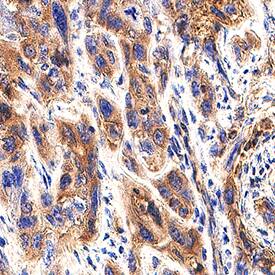Human BMP-2/BMP-4 Antibody
R&D Systems, part of Bio-Techne | Catalog # AF355


Key Product Details
Species Reactivity
Validated:
Cited:
Applications
Validated:
Cited:
Label
Antibody Source
Product Specifications
Immunogen
Gln283-Arg396
Accession # P12643
Specificity
Clonality
Host
Isotype
Scientific Data Images for Human BMP-2/BMP-4 Antibody
Detection of BMP-2/BMP-4 in Human Lung Cancer.
BMP-2/BMP-4 was detected in immersion fixed paraffin-embedded sections of human lung cancer using Goat Anti-Human BMP-2/BMP-4 Antigen Affinity-purified Polyclonal Antibody (Catalog # AF355) at 0.5 µg/ml for 1 hour at room temperature followed by incubation with the Anti-Goat IgG VisUCyte™ HRP Polymer Antibody (Catalog # VC004). Before incubation with the primary antibody, tissue was subjected to heat-induced epitope retrieval using VisUCyte Antigen Retrieval Reagent-Basic (Catalog # VCTS021). Tissue was stained using DAB (brown) and counterstained with hematoxylin (blue). Specific staining was localized to the cytoplasm. View our protocol for IHC Staining with VisUCyte HRP Polymer Detection Reagents.Applications for Human BMP-2/BMP-4 Antibody
Immunohistochemistry
Sample: Immersion fixed human BMP-2 transfected cells
Western Blot
Sample: Recombinant Human BMP‑2 (Catalog # 355-BEC)
Recombinant Human BMP‑4 (Catalog # 314-BP)
Reviewed Applications
Read 1 review rated 5 using AF355 in the following applications:
Formulation, Preparation, and Storage
Purification
Reconstitution
Formulation
*Small pack size (-SP) is supplied either lyophilized or as a 0.2 µm filtered solution in PBS.
Shipping
Stability & Storage
- 12 months from date of receipt, -20 to -70 °C as supplied.
- 1 month, 2 to 8 °C under sterile conditions after reconstitution.
- 6 months, -20 to -70 °C under sterile conditions after reconstitution.
Background: BMP-2/BMP-4
Human BMP-2 is one of at least 15 structurally and functionally related BMPs, which are members of the transforming growth factor beta (TGF-beta) superfamily. BMPs were originally identified as protein regulators of cartilage and bone formation. However, they have since been shown to be involved in embryogenesis and morphogenesis of various tissues and organs. BMPs have also been shown to regulate the growth, differentiation, chemotaxis and apoptosis of various cell types, including mesenchymal cells, epithelial cells, hematopoietic cells and neuronal cells. Similarly to other TGF-beta family proteins, BMPs are highly conserved across animal species. At the amino acid sequence level, mature human, mouse and rat BMP-2 are 100% identical. BMP-2 is synthesized as a large precursor protein that is cleaved at the dibasic cleavage site (RXXR) to release the carboxy-terminal domain. Biologically active BMP-2 is a disulfide-linked homodimer of the carboxy-terminal 114 amino acid residues that contains the characteristic seven conserved cysteine residues involved in the formation of the cysteine knot and the single interchain disulfide bond. Cellular responses to BMP-2 have been shown to be mediated by the formation of hetero-oligomeric complexes of type I and type II serine/threonine kinase receptors. One BMP type II and two BMP type I receptors have been identified. In contrast to the TGF-beta type I receptor, which does not bind the ligand in the absence of the TGF-beta receptor type II, both BMP receptor type Is can bind BMP-2 with high-affinity in the absence of BMP receptor type II.
References
- Kawabata, M. et al. (1998) Cytokine and Growth Factor Reviews 9:49
- Ebendal, T. et al. (1998) J. Neurosci. Res. 51:139.
- Reddi, A.H. (1998) Nature Biotechnology 16: 247.
Long Name
Alternate Names
Gene Symbol
UniProt
Additional BMP-2/BMP-4 Products
Product Documents for Human BMP-2/BMP-4 Antibody
Product Specific Notices for Human BMP-2/BMP-4 Antibody
For research use only